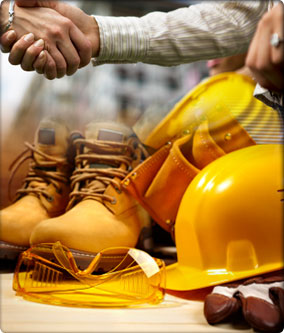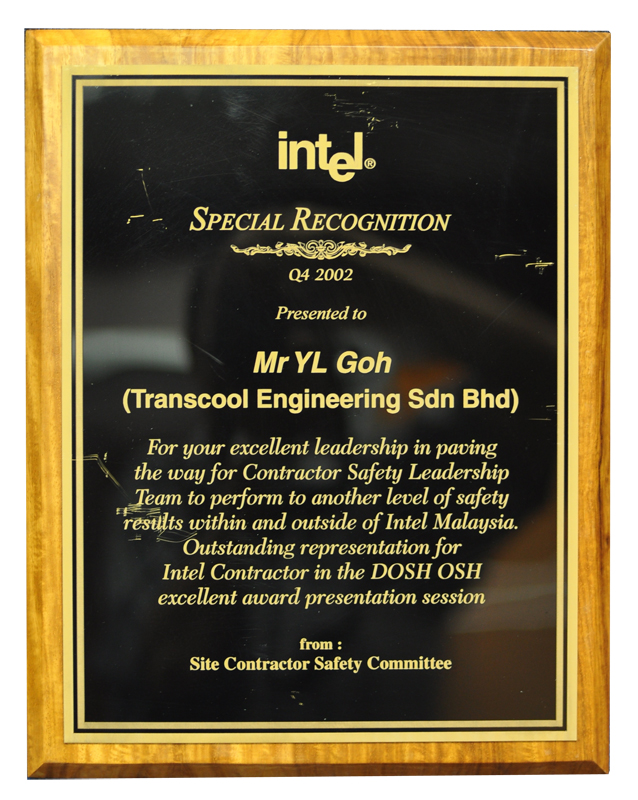

Occupational Safety And Health Policy
Transcool Engineering Sdn Bhd will provide safe and healthy working conditions and environment at our work places by creating safe work practices and procedures to prevent injuries. Our ultimate aim is to develop a safety culture amongst our employees. We plan to achieve this objective by maintaining high levels of safety awareness through con ti no us education and training. We are dedicated in safeguarding the safety and health of the general public and the environment against pollution of the waterways, air space and ground. To realise the above the top management will be proactive, fully committed and supportive of all safety and health activities within the Company.

PROJECT SITE SAFETY & HEALTH COMMITTEE
- Every project site where there are more than 40 employees a Safety and Health Committee (SHC) will be formed. The composition of the SHC is as follows:
- Chairman - Project Manager
- Secretary - Safety and Health Officer (SHO) or Safety Coordinator
- Members -
- Employer’s representatives(4 persons)
- Workers Representatives (4 persons)
- The project site SHC shall meet at least once every fortnight.
- The SHC members must possess at least 1-year working experience in construction activities.
- The SHC shall conduct itself in accordance with the requirements of Occupational Safety and Health Act (OSHA) 1994 and its supporting regulations: Occupational Safety and Health (Safety and Health Committee) Regulations 1996.
SAFETY INDUCTION
- Any person who enters our project site to work is required to attend a DOSH or CIDB approved Safety Induction.
- Any person wishing to enter our project’s Personal Protective Equipment (PPE) zone shall attend a Transcool safety induction before he is allowed entry. Safety Induction Form is shown at TE 1.
- A Safety and Health Officer, Safety Coordinator or a Site Supervisor may conduct the safety induction.
- The safety induction shall be programmed such that it is available daily from 9:00 am to 10:00 am or at such time fixed by the site management.
- A room shall be provided for safety induction. Instructional aids like overhead projector, TV, video and whiteboard shall be made available.
- Safety induction briefing notes for workers is shown at TE 2. Briefing notes for visitors is shown at TE 3 and vendors at TE 4.
- Safety induction for workers shall include a video presentation on construction safety.
- Every worker that has been safety inducted shall be given a copy of safety induction guidebook.
- Following an induction the worker will be issued with a temporary security gate pass. A permanent security gate pass will be issued within 10 days of induction.
- The SHO or the safety coordinator shall maintain a record of all inductions carried out.
- If a worker is found in the PPE zone without being safety inducted he is subject to be issued with a safety violation.
- Any worker that has been issued with a safety violation is required to be re-inducted in the presence of his immediate supervisor.
- The SHO or the safety coordinator shall maintain statistical records of workers who have been safety inducted according to their trade. Format for his is shown at TE 5.
TOOL BOX MEETING
- Tool Box Meeting (TBM) is compulsory and shall be programmed such that every worker from the respective trade will have to attend at least one TBM per week. Format for TBM roster is shown at TE 6.
- We will provide a room to conduct TBM. Instructional aids like overhead projector, TV, video and whiteboard shall be made available.
- A SHO/safety coordinator or site supervisor may conduct the TBM.
- The SHO/safety coordinator shall use a form to record of all TBMs carried out. The format for the TBM record is shown at TE 7.
- The SHO/safety coordinator shall maintain statistical records of workers who have attended TBM according to their respective trades. Format for this is shown at TE 8.
PERSONAL PROTECTIVE EQUIPMENT
- We will demarcate a Personal Protective Equipment (PPE) zone within the project site where the wearing of PPE is mandatory.
- The minimum PPE requirements for every project site is:
- Safety helmet
- Safety shoes/waterproof boots
- Full body harness (for work above 3 meters)
- Safety spectacles for hazardous work.
- The minimum quality for the above PPE shall be:
- Safety helmet – Approved by DOSH
- Safety shoes/water boots – Approved by DOSH
- Full body harness – Approved by DOSH
- We will maintain a PPE store within each project site that will be stored with sufficient numbers of relevant PPE for replacement of loss/damaged PPE.
- The provision of PPE to the workers, visitors, vendors is as below:
- We will provide PPE to all our direct employees.
- Subcontractors will provide PPE for their employees.
- We will provide PPE to any visitor and vendor to the project.
- The site management will implement safety helmet colour coding system for major subcontractors.
- For hot works like welding, cutting, grinding and chipping, we will provide the worker with eye protection equipment.
- For other dangerous works that involve the handling of chemicals, glass and sharp objects we will provide hand protection equipment and/or protective clothing.
- For work in dusty environment we will provide the worker with dust mask.
- The design, construction, use and maintenance of every personal protective clothing, device, apparatus and other equipment shall conform to safety standards acceptable by the Director General of DOSH.
SAFETY MEETING
- The safety meeting shall be guided by the provisions of the Occupational Safety and Health (Safety and Health Committee) Regulations 1996.
- The Safety and Health Committee at the Project Site shall meet to discuss OSH matters once a fortnight or at suitable internal as decided from time to time by the site management.
- The PM shall chair the Safety Meeting.
- The SHO or the Safety Coordinator shall be the secretary to the Safety Meeting.
- Minutes of the Safety Meeting shall be recorded and kept.
- The SHO is responsible to determine the date and time of the Safety Meeting.
EMERGENCY RESPONSE PROCEDURE
- Every project shall have a written Emergency Response Procedure (ERP). This procedure must be fully understood by every project management staff, safety observers and workers.
- During an emergency the information on the incident or accident must be passed by the PM to the Managing Director (MD) within one hour.
- The PM will then assemble and chair an incident/accident investigation team comprising:
- Safety and Health Officer
- Safety and Health Observer
- The accident/incident investigation team shall use the investigation format at TE 16.
- The PM has to complete his preliminary report and submit to the MD within 24 hours.
- The duty to inform the project owner of the incident/accident rests with the MD.
- In cases where the incident/accident requires a report be lodged with the Department of Occupational Safety and Health (DOSH), the Police Department or the Department of Environment (DOE), the PM shall initiate it.
- In cases where the project insurer’s intervention is required the PM is responsible to initiate it as soon as possible.
- The PM is responsible to submit his full report to the MD within one week of the incident/accident.
- The Safety Department at the Headquarters shall study the incident/accident report and promptly shore the salient information contained therein with other PMs with a view to avoid recurrence within the Company’s other projects.
- Each project site should have personnel who are trained in first aid and CPR or managing injuries in construction sites. Such personnel shall be the first responders during an accident involving injuries to workers.
- The telephone numbers of BOMBA, the Police Department, the nearest hospital and DOSH shall be prominently displayed in the project site.
FIRE PROTECTION
- There will be strictly no open burning in any of our project sites.
- Basic fire protection information for workers will be conducted during tool box meetings.
- For carrying out hot works the subcontractor shall apply for a hot work permit from the site safety and health officer/representative. A hot work permit form is shown at TE 17.
- All users of industrial gas like acetylene/oxygen are to ensure that the cylinders are provided with gauges and flash back arrestors. The gas hose are to be examined regularly to detect leaks.
- All workers are required to remove debris created by them at the end of every work day.
- Fire drills and training shall be organised regularly.
- The PM will ensure that all conditions and requirements of the project’s insurance policy are adhered to.
- For a large project, the site management shall organize a fire fighting team and equip them with relevant equipment to fight a fire.
- A siren shall be provided and a fire warning system implemented and understood by all employees.
- The cooking area (kitchen) shall be separated from the living area within the workers quarters’ complex. No cooking is allowed in the living area.
- Emergency telephone contact numbers shall be prominently displayed in the project site.
- The project management shall ensure that no workers quarters are constructed with a direct access to the project site.
- Smoking is not allowed within the PPE Zone.
- For welding works the electric supply shall be from a generator. A fire extinguisher shall be placed nearby for emergency use.
CHEMICAL SAFETY
- The health of the worker handling chemicals is given priority.
- Any worker, when he is handling a chemical or a chemical based product or material, shall be provided with the relevant personal protective equipment (PPE) like eye protectors, helmet, gloves, safety shoes, respirators, dust masks etc.
- Safe handling procedure shall be determined before the start of work. The MSDS shall be referred.
- The management shall give particular attention to the storage and transportation of chemicals. In this respect, the quantities allowed to be stored within a project site must be determined.
- The subcontractor or supplier shall be required to submit to the safety department the Material Safety Data Sheet (MSDS) for the chemical/materials/product before bringing them into the site.
- Sufficient safety signs and information shall be provided at areas where chemicals are used and stored.
- Action to correct misuse or mishandling of chemicals shall be promptly attended to.
- The management shall provide training to ensure that workers are aware of the risks involved in the handling of chemicals. Information must also be readily available.
- The management shall prepare a procedure for attending to chemical spillage, body contact, swallowing or inhaling of chemical vapours, mist or gas. This should be addressed during preparation of WIPP.
- Empty chemical containers shall be disposed correctly and in accordance with manufacturer’s recommendation.
- Measures must be taken to prevent outbreak of fire when chemicals are used. Where relevant fire extinguishers shall be provided.
- All chemicals delivered at site must be labeled as required under the CLP Regulations. Chemicals without appropriate labels must not be accepted and returned to the supplier.
- New Regulations on user of Chemical.





